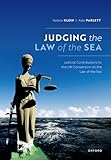Judging the law of the sea : judicial contributions to the UN C onvention on the Law of the Sea / Natalie Klein, and Kate Parlett.
Material type: TextPublisher: Oxford, United Kingdom ; New York, NY : Oxford University Press, 2022Edition: First editionDescription: i - xl, 424 pages ; 25 cmContent type:
TextPublisher: Oxford, United Kingdom ; New York, NY : Oxford University Press, 2022Edition: First editionDescription: i - xl, 424 pages ; 25 cmContent type: - text
- unmediated
- volume
- 9780198853350
- 9780198853350
- 23rd 341.78 KLE
- KZA1120.3 .K58 2022
| Item type | Current library | Collection | Call number | Copy number | Status | Notes | Date due | Barcode | |
|---|---|---|---|---|---|---|---|---|---|
| Reference Book | VIT AP School of Law LAW Section | Reference | 341.78 KLE (Browse shelf(Opens below)) | LA02663 | Not For Loan | LAW | 021884 |
It includes contents, list of treaties, bibliography and index pages
Includes bibliographical references (pages 405-418) and index.
1. Introduction -- 2. The role of judges -- 3. Preliminary matters, incidental and other proceedings -- 4. Subject matter jurisdiction -- 5. Maritime space -- 6. Maritime boundary delimitation -- 7. Navigation -- 8. Fisheries -- 9. Marine environment -- 10. Judging the law of the sea.
"The dispute settlement regime in the UN Convention on the Law of the Sea (UNCLOS) has been in operation for well over twenty years with a steadily increasing number of important cases. This significant body of case law has meaningfully contributed to the development of the so-called 'constitution of the oceans'. Judging the Law of the Sea focusses on how judges interpret and apply UNCLOS and it explores how these cases are shaping the law of the sea.The role of the judge is central to this book's analysis. The authors consider the role of UNCLOS judges by engaging in an intensive study of the their decisions to date and assessing how those decisions have influenced and will continue to influence the law of the sea in the future. As the case law under UNCLOS is less extensive than some other areas of compulsory jurisdiction like trade and investment, the phenomenon of dispute settlement under UNCLOS is under-studied by comparison. Cases have not only refined the parameters for the exercise of compulsory jurisdiction under the Convention, but also contributed to the interpretation and application of substantive rights and obligations in the law of the sea. In relation to jurisdiction, there is important guidance on what disputes are likely to be subjected to binding third-party dispute resolution, which is a critical consideration for a treaty attracting almost 170 parties.Judging the Law of the Sea brings together an analysis of all the case law to the present day while acknowledging the complex factors that are inherent to the judicial decision-making process. It also engages with the diverse facets that continue to influence the process: who the judges are, what they do, and what their roles might or should be. To capture the complex decision matrix, the authors explore the possible application of stakeholder identification theory to explain who and what counts in the decision-making process." -- Publisher's website.
There are no comments on this title.

